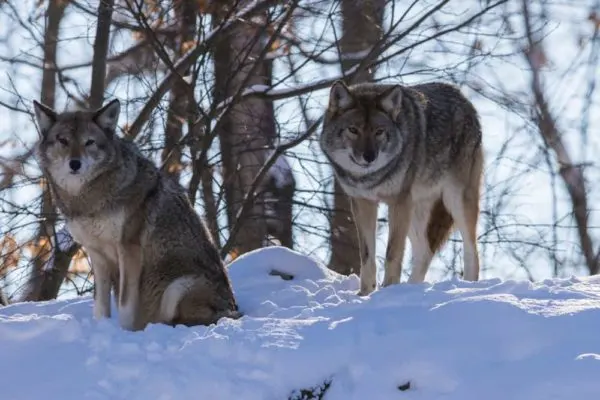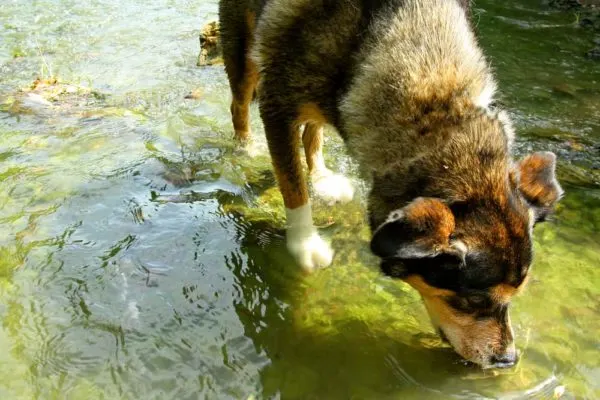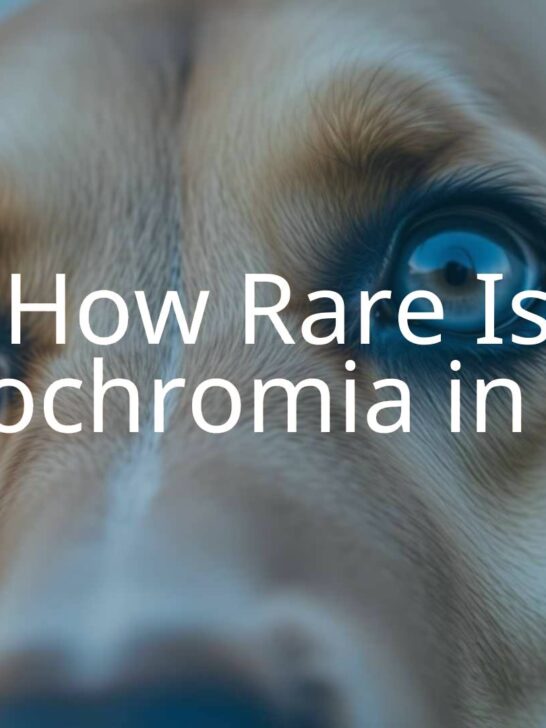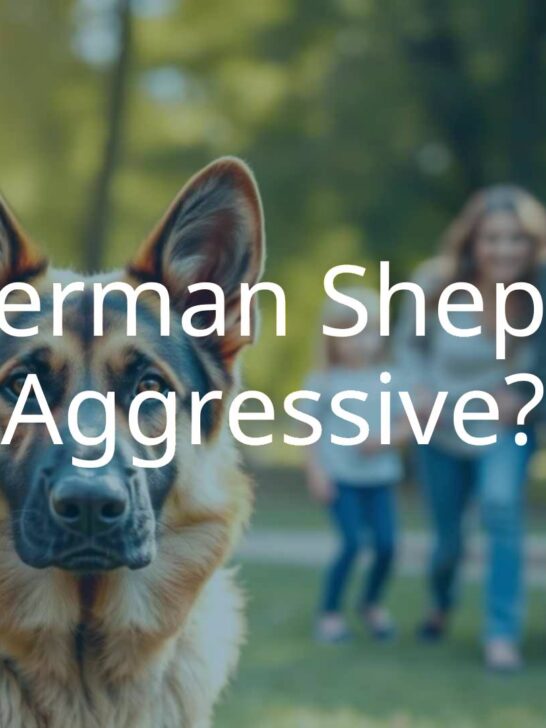Coyote German Shepherd Mix: Meet The Rare, Elusive And All Too Real Coydog
The coydog, or coywolf, sounds like a creature straight from fiction. Half dog, half-wolf, surely this mysterious canine must be an urban myth.
And yet this is not entirely the case. The coydog may be rare and often deeply misunderstood, but real animals that fit this description do exist.
In some states such as Vermont, the calls of coydogs are easily distinguishable from the calls of either domestic German Shepherd dogs or wild wolves.
In this article, learn everything you need to know about the Coyote German Shepherd mix known as the coydog or coywolf.
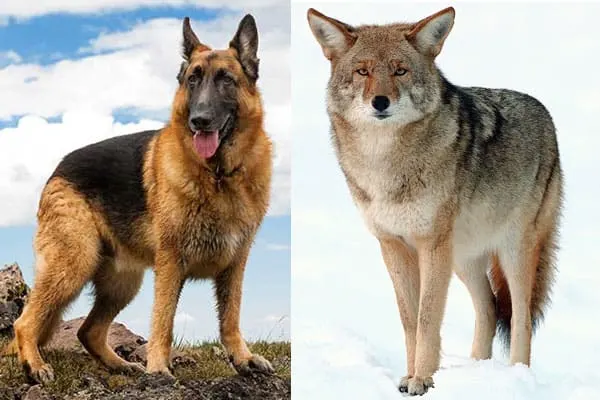
The History and Taxonomy of the Modern Coyote German Shepherd Mix Dog
Biologists explain that the modern coywolf is not all wolf, not all coyotes, and not all dogs. Rather, this unique canine has inherited genes from all three species.
This means the proper term to use might be “coywolfdog.”
Specifically, the distribution of genes from at least the eastern contingent of coywolves typically looks like this:
- 60 percent coyote
- 30 percent wolf (eastern wolf and/or grey wolf)
- 10 percent domestic dog
This short video shows you what a pairing between a coyote and a German Shepherd might look like.
However, the exact percentages can vary quite a bit based on where the hybrid canine lives geographically.
This places all three species, the coyote, the wolf, and the domestic dog, into a greater group of related animals, called a “clade.”
It also represents an example of cladograms, the hybridization (crossbreeding) between related species.
All domestic dogs are now thought to be descended from wild wolves.
This means that all dogs, including the German Shepherd dog breed, already share a genetic link to their wild cousins.
But what is the connection that dogs and wolves share with coyotes?
As Scholastic researchers explain, coyotes and wolves also share a great deal of DNA.
This means that, in addition to the coydog, the coywolf is actually a similar but separate crossbreeding.
What is most important to remember here is that the coyote, the wild wolf, and the domestic dog are all closely related from a genetic basis.
This means that all three can potentially crossbreed with each other to produce viable offspring.
Recall the coywolf example from the introduction – biologists determined it contains genetic influence from wild wolves, coyotes, and domestic dogs.
But for technical purposes, the terms coydog and coywolf are used to describe two different cross breeding outcomes as follows:
- Coydog: Coyote German Shepherd mix dog breed.
- Coywolf: Coyote wild wolf mix breed.
Now let’s dive deeper into the Coyote German Shepherd mix specifically.
Intro To The Coyote German Shepherd Mix: A Brief History
The Coyote German Shepherd mix is sometimes called a canid hybrid.
This simply means that the dog has received genetic influence from different canid (canine) species.
The best way to start learning about these unique hybrid dog breeds is to examine the history of each parent species.
In this case, it’s the coyote and the German Shepherd dog.
The Coyote: a brief history
As National Geographic explains, coyotes, or “prairie wolves” as they are sometimes called, have existed in North America for at least one million years!
Coyotes have a signature howling call and a history of near-continual persecution.
The coyote has a cartoon character, Wile E. Coyote, to thank for the grudging public support it has since received.
In direct contrast to how settlers have traditionally viewed coyotes, much of Native American culture sees coyotes as a positive force and even a deity.
Coyotes are related quite closely to another canid species, the golden jackal.
The golden jackal hails from Africa and the two species began to evolve separately as recently as 80,000 years ago.
Today, coyotes have proven they can thrive in both their natural wild setting and in urban areas while living alongside people.
However, they don’t make suitable pets.
The German Shepherd dog: a brief history
The German Shepherd, in contrast, is one of the most popular pet dogs in America – the second most popular to be exact.
According to the American Kennel Club (AKC), the German Shepherd ranks second out of 195 registered purebred dog breeds.
The GSD, as fans often nickname this dog breed, has a long and distinguished history that dates back to the 19th century.
These dogs are famous for serving as herding and livestock guarding dogs.
They’re also known for their work as police and military dogs, search and rescue dogs, service and therapy dogs, and more recently as canine companions.
They’re also celebrated for their roles in popular movies, like GSD canine stars Rin Tin Tin and Strongheart.
The German Shepherd is also a tremendous natural athlete – one of the dog world’s finest.
These dogs can do it all – run, jump, swim, track, hunt, herd, and, of course, protect, and guard.
What does this tell us about the Coyote German Shepherd mix? It tells us that this canine is going to be smart, resilient, athletic, tireless, and strong.
But it doesn’t tell us anything about this hybrid breed’s potential for living in a domestic setting alongside human caregivers.
For that information, we need to dig deeper into aspects like personality and temperament, trainability, and exercise needs.
A Note On Crossbreeding Domestic and Wild Canines
While numerous hybrid canid species exist, and interbreeding between coyotes, jackals, wolves and domestic dogs isn’t uncommon, it’s not recommended.
Depending on what area you happen to live in, it’s also not always legal.
Even if the breeding itself happens without your knowledge, it may still be illegal to keep such hybrid canids in captive settings as companion canines or pets.
If you wish to live with a hybrid canid, you should check with your local city, county, and state regulations regarding wild animals before making this commitment.
As well, be aware that no ethical dog breeder should enter into a hybrid breeding program where one canine parent is a wild species.
Any breeder advertising the sale of coywolfdogs or similar hybrid canid puppies should be dealt with cautiously.
Coyote German Shepherd Mix: Personality and Temperament
As with any hybrid canid, whether a fully domestic dog or mix-species, it can be challenging to correctly predict adult temperament in advance.
This is just the nature of the hybrid breeding process.
The earliest generations (F1) of crossbred puppies will each inherit an unpredictable mix of genes from each parent canine.
Coyotes are mostly solitary in the wild, according to Live Science. The exception is when it’s time to hunt.
Packs form and hunt in relay teams so they can outlast fleet prey like deer.
A coyote will mark their territory by urinating. Unlike domestic dogs, they’re largely nocturnal and are most active at night, especially when on the hunt.
Their trademark vocalization, a haunting howl, helps solitary coyotes communicate with one another over very long distances.
The German Shepherd dog may seem intimidating to strangers, but to “their” people, there’s no dog more loving, loyal, and affectionate than the GSD.
German Shepherds really need and want to be with their human families.
These dogs don’t do well when left alone or in the company of other dogs for hours each day.
Because of the GSD’s strong instincts to herd, guard, and protect, these dogs can be aloof with strangers – both animals and people.
Given that the coyote has no history of domestication, they don’t adapt easily or readily to domesticated life. They have no concept of training or life as human pets.
In rare cases, coyote kits (babies) have been hand-reared and tamed by humans.
But as these babies grow and mature sexually, they’re likely to revert to their wild ways. They may even be a danger to their human caregivers and domestic animal species.
What does this mean for a coyote German Shepherd mix living in captivity?
It means there’s no guarantee the kit (puppy) will grow up to adapt well to life as a pet or even as an ambassador animal.
However, this isn’t to say that it’s impossible!
Coyote German Shepherd Mix: Size, Height, and Weight
Of the two canids, the German Shepherd domestic dog is always going to have the advantage in size, height, and weight.
However, what the coyote lacks in size this canid will more than make up for in energy and prey drive.
An adult coyote can weigh anywhere from 20 to 50 pounds.
The California Wolf Center states that an adult coyote typically stands anywhere from 21 to 24 inches from paw pads to shoulders.
As with many domestic dog breeds, wild coyotes will often differ in size, height, and weight in adulthood.
Adult males will weigh more and stand slightly taller than adult females.
The German Shepherd dog in adulthood may stand anywhere from 22 to 26 inches (paw pads to shoulders) and weigh anywhere from 50 to 90 pounds.
Typically the adult male German Shepherd dog will stand up to four inches taller and weigh 15 to 20 pounds more than the adult female GSD.
The coyote is sized more like a medium domestic dog. In contrast, the German Shepherd dog is clearly in the large dog category for both height and weight.
A coyote German shepherd mix will most likely weigh between 30 and 70 pounds, but this will depend to a great degree on the size, height, and weight of each canine parent.
A small coyote and a small GSD will produce much smaller kits (puppies) than would the pairing of a large coyote and a large German Shepherd.
Coyote German Shepherd Mix: Exercise & Training Needs
The area where the coyote and the German Shepherd are perhaps the most similar is in their natural energy levels. These are both very active, energetic canids.
However, where there is a marked difference is when it comes to active hours.
The German Shepherd has been bred to be highly attuned to and protective of both people and livestock.
As such, the GSD keeps daytime hours, waking and sleeping with “their” people.
In contrast, the coyote is known to be largely nocturnal – hunting, patrolling their territory and moving about at night, and sleeping during the day.
A full-grown adult coyote can easily run up to 30 miles per hour. Wild adult coyotes aren’t “trainable” by any standard used to judge the adult domestic dog.
However, there are cases where hand-reared coyote kits (pups) have been trained to some degree by human carers.
German Shepherds have an abnormally strong herding and guarding drive.
Due to this, they benefit greatly from early and ongoing socialization – around both strange people and new animals.
This early and ongoing training will ensure the adult GSD is able to adjust well to living in a family and community.
GSDs are bred to work tirelessly and with single-minded intensity and focus. A bored German Shepherd is very likely to become a destructive dog.
For pet GSDs, getting involved in agility or services can be a great outlet for their energy.
However, because the German Shepherd can continue to grow and mature for up to 36 months, care must be taken not to allow exercise that’s too-vigorous in puppyhood.
This can cause GSDs pain in bones and ligaments, and even lead to skeletal injury in some cases.
A coyote German Shepherd mix is guaranteed to be extremely high energy, driven, and athletic.
This hybrid canine will need lots of activity and enrichment to adapt at any level to life in ‘captivity’.
Although it may not be feasible given personal situations, training will be most productive for this mixed breed dog in puppyhood.
Coyote German Shepherd Mix: Shedding, Coat, and Grooming Needs
Both coyotes and German Shepherds have protective coats that consist of two layers: a water-resistant, thick outer layer and a soft, downy insulating underlayer.
Because the coat is so important to the canine’s health, both species shed year-round and more heavily with the changing seasons.
You can expect an adult coyote German shepherd dog hybrid to need at least weekly brushing and the occasional bath to stay healthy.
Coyote German Shepherd Mix: Longevity and Health Issues
Coyote longevity and health
A wild coyote has a life expectancy in the teens, but the average lifespan of wild coyotes is only around three years.
Life in the wild can be very hard! In captivity, a coyote may live up to 14 years.
Coyotes can be susceptible to a wide range of health issues and diseases, including some that are zoonotic (transmissible to humans).
The Urban Coyote Research Project cites these particular health issues that coyotes are known to develop:
- Heartworm
- Mange
- Rabies
German Shepherd longevity and health
As with many large dog breeds, the German Shepherd has a shorter overall life expectancy than their smaller breed peers.
The typical GSD life expectancy ranges from seven to 10 years.
German Shepherds can inherit certain serious health conditions that may be life-limiting.
The Canine Health Information Center (CHIC) database states that all GSDs involved in breeding programs should be pre-tested for these health conditions:
- Hip and elbow dysplasia
- Cardiac and eye issues
- Temperament
- Autoimmune thyroiditis
- Degenerative myelopathy
Coyote German Shepherd mix longevity and health
We can see that the majority of known heritable (genetic) health issues will come from the GSD parent canine.
Overall, the life expectancy of a coyote GSD mix in a captive setting is likely to average around 10 years.
Frequently Asked Questions
Can a German Shepherd breed with a coyote?
Yes! It is indeed possible that a German Shepherd can breed with a coyote. Whilst the occurrence is rare, particularly these days, it has happened before and could certainly happen again.
Dogs derive from coyotes and wolves, and so they share many of the same features and characteristics.
Mating between dogs and coyotes produces offspring known as coydogs. Because of the appearance of the German Shepherd with its wolf and coyote-like features, their offspring do not look wildly out of place.
It is worth bearing in mind that whilst crossbreeding between a German Shepherd and a coyote is possible it is not recommended. Some states criminalize this.
The reason for this is that the offspring of this breeding match may be unsociable, difficult to train, and may even be dangerous.
Some states will even make you give up the offspring of an accidental coyote and German Shepherd breed!
Can a dog impregnate a coyote?
Yes, a dog can impregnate a coyote. That being said, it is not easy, since the fertility cycle of a female coyote is very different from that of a female dog. Coyotes tend to have just one opportunity for pregnancy per year.
This is in comparison to dogs who can have a number of them.
Male dogs in particular are able to copulate all year round. This means that the chances of a male dog impregnating a coyote female at the exact right time are slim.
Even if the male dog did manage to impregnate the female coyote, it is certainly not recommended. It may even be illegal, as you know. The offspring of a dog and coyote could be dangerous.
That is not to mention the illnesses and genetic conditions it can inherit from the feral coyote.
Coyote German Shepherd Mix: Would You Ever Add a Coydog to Your Family?
It can be so interesting to learn about the genetic links between different species of canids such as the wolf, the coyote, and the domestic dog.
But unless you have a permit or license, and the proper setup to care for this unique canid, it’s not advisable to take on such a responsibility with so many variables and unknowns.














